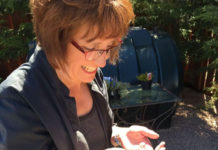Curiously, and perhaps eagerly, I am looking at a bull terrier named Sputnik, searching for a resemblance. He’s a stocky three-year-old, mostly slate grey, with a white stripe on his head and a pink splotch on his elongated, bull-terrier nose. So far, our only similarity is we’re both waiting in an examination room at Tuft’s veterinary school in North Grafton, Massachusetts.
Sputnik has canine compulsive disorder (CCD) and is at Tuft’s for a checkup with Nicholas Dodman, a veterinarian who has been studying CCD for more than two decades. I’m shadowing this visit to learn about Dodman’s work and, selfishly, to learn something about myself: I was diagnosed with obsessive compulsive disorder a few months ago.
When Dodman first started seeing these dogs, he realised he had been handed a potentially ideal animal model through which to study human OCD. But over 20 years of studying dogs, discovering potential candidate genes and new neural pathways, one problem has continually clouded his research: the question of whether CCD can truly be compared to human OCD. “People have a mental block,” he says. “The mind is thought of as uniquely human.”
Sputnik was a tail chaser, and would spin for hours on end. At the moment, he is completely still. Like me, it seems he keeps his obsessive side away from the public eye.
Tail-chasing is a common compulsive behaviour for dogs, and for bull terriers specifically. Particular breeds have particular behaviours they exhibit with CCD. Dobermans lick their limbs and suck their flanks, labradors hold objects or chew rocks, and King Charles spaniels snap at imaginary flies. While these behaviours sound trivial, when performed to the extreme they take over eating, sleeping and all basic functioning.
Sputnik steps out from the safety of Dodman’s shadow, timidly eating treats. “Over the last two years, he has gone from being a dog that was going to have to be put down, to being a normal dog,” says his owner Dan Schmuck. “He maybe looks at his tail once a day. It’s a miracle.”
Sputnik is on Prozac now, along with a few other medications to temper his behaviour. Could Sputnik be like me, a person with OCD? Was he thinking about his tail right now, somewhere in the recesses of his doggy mind?
“You can’t access an animal’s thoughts, so the purists call it only canine compulsive disorder, not obsessive compulsive disorder,” Dodman says. “But it looks for all the world, when Dan is holding Sputnik back, that he’s constantly thinking about it. That’s an obsession.”
In 1989, a popular science book called The Boy Who Couldn’t Stop Washing was published. Its author, Judith Rapoport, then chief of the child psychiatry branch at the National Institute of Mental Health in Maryland, had studied and treated all kinds of neuropsychiatric illness, but a fascination with OCD grabbed hold of her. These patients had to participate in detailed rituals and compulsions to assuage strange beliefs: that they had just killed someone, that everything was contaminated, that they had sinned in some way, that things had to be just right.
Rapoport’s book was one of OCD’s first steps into the spotlight. Millions of people began to understand something about their own odd behaviours, or those of their friends and family members. (We now know OCD affects 1-3% of the population.) Soon, Rapoport started to get letters and phone calls – including some with questions she hadn’t expected. “A whole bunch of them talked about their dogs,” she says.
Judith Rapoport, whose 1989 science book, The Boy Who Couldn’t StopWashing, helped bring OCD to wider attention. Photograph: Jim Spellman/WireImage
People wrote that their dogs had these behaviours too. Did she think they had OCD? “If people ask one weird question, you shrug it off,” she says. “But if 20 of them ask it, you pay attention.”
A dog-owner herself, she asked her vet about acral lick, when a dog licks or sucks at its paw or leg until the fur and flesh are worn through, leading to infection, amputation and sometimes death. Her vet said his dog suffered from it. She asked if he would be willing to try medication – the same one given to people with OCD, which blocked the re-uptake of serotonin, increasing its levels in the brain.
“We put his dog on a dose, and it had a remarkable response,” she says. “You could say this all started when I cured my vet’s dog.”
Encouraged, Rapoport designed a double-blind placebo study. Dogs with acral lick received either a drug for OCD (Prozac or clomipramine), a placebo, or an antidepressant that worked for depression but not OCD and wouldn’t alter serotonin levels. The results were “dramatic”: the only group that improved was the group that got the serotonin drugs.
Still, Rapoport took her findings with a grain of salt. As a psychiatrist, she usually needs to know what her patients think of their compulsions to give them a true OCD diagnosis: “Patients with OCD say ‘I think this is crazy what I’m doing, but I can’t stop,’” she explains. “Well you can’t get that sort of information from animals, so animal models are often very limited for psychiatry.”
After publishing, Rapoport moved back to human patients. But her work caught the attention of a veterinary anaesthesiologist with an interest in behaviour: Nicholas Dodman.
Elaine Ostrander has been working in dog genetics for 25 years. “The reason canine genetics are so cool is one word,” she tells me. “Breeds.” Ostrander is the chief of the cancer genetics and comparative genomics branch at the National Human Genome Research Institute of the NIH. Her lab develops dog genome databases to look for disease genes that could be important for animal health or translate to humans. “If you want to understand the genetic underpinning of a complex disease, we know there’s lots of genes involved,” she says. “In human populations, there are dozens of genes that contribute. Every family is a little bit different, some genes seem hereditary, some seem not to be, it’s a very complex mosaic. In dogs, you simplify that mosaic.”
In 1994, it was Ostrander who provided the genetic data when Dodman teamed up with Alice Moon-Fanelli, an animal behaviour geneticist, to begin to explore the genetics of his dog patients. Moon-Fanelli started to gather phenotypes, the expression of those genes: including the details of each dog’s behaviour, along with their breeds, pedigrees, age of onset, and anything else that might be useful. Moon-Fanelli says that when they started, the idea of CCD wasn’t widely accepted. Animal repetitive behaviours were considered “stereotypies” – mindless actions that were a result of poor environment or boredom. “Looking at almost 400 bull terriers over the years, and all the dobermans and cats, it became clear it wasn’t because of a suboptimal environment,” she says. “These animals were pets, they had great lives in wonderful homes.”
The dogs’ symptoms usually started around puberty, as is often the case in people. Compulsive behaviours ran in family lines, just like people. And just as human psychology had to realise that OCD wasn’t a result of upbringing, animal medicine was doing the same.
“One living species to another, you know that they are obsessing and that they are possessed by demons that they cannot control,” says Moon-Fanelli. “And it’s the same thing with people. It’s just that people speak the same language so they can tell us what they’re thinking. ”
We don’t know exactly what goes wrong in the brain to cause OCD. We do know that drugs like Prozac (SSRIs), which increase serotonin levels, seem to help – but only in some people. About half of people see a response to the SSRIs and a “successful” response can mean as little as a 35% reduction of symptoms.
Whether you believe in a dog model or not, one thing is becoming clearer in human OCD research: serotonin is not the complete story.
Dodman had concluded from work with horses with the 1980s that glutamate seems to be important. Recent neuroimaging of people with OCD has shown increased blood flow and activation in the cortico-striato-thalamocortical (CSTC) circuits, a network that loops from the deep centres of the brain to the prefrontal cortex. This area is dominated by glutamate pathways that are thought to generate controlled movement and thought, and to modulate behavioural routines. Some OCD researchers now hypothesise that SSRIs work not because of serotonin, but because they stop the release of glutamate. Further work testing the cerebral spinal fluid levels of people with OCD found that they had significantly higher levels of glutamate.
Still, knowing that glutamate plays a role, in dogs or in people, doesn’t help discover the genes that cause this dysregulation in humans, which is where an accurate animal model could be extremely helpful.
“The problem with the large number of behavioural disorders is that we don’t really have a good clue as to what the underlying molecular change is,” says Ed Ginns, a neurologist and geneticist who works with Dodman. “If we can at least get that, we’re confident that, pathways and even potential targets for treatment can be identified.”
When he first met Dodman, Ginns had been studying bipolar disorder and depression in genetically closed populations such as the Amish. For him, it was never an issue that Dodman’s sample was built of dobermans and terriers. He says it was compelling because, like the Amish, the dogs’ disorder had arisen naturally.
Their first collaboration was a genome-wide analysis on 92 flank- and blanket-sucking doberman pinschers compared with 68 control dobermans. They got one strong statistical hit called neural cadherin or CDH2. In the brain, CDH2 is involved in the development of glutamate receptors.
“Everyone basically took a big breath and stepped back,” Dodman says. This was the first behavioural gene that had ever had anything to do with OCD, and one of the few behavioural genes that have been discovered.”
“One dog, obsessed with water, would jump into the pool and do laps for seven hours, whining in anxiety the whole time.”
The next step was to look for CDH2 in people. The results were inconclusive. “We didn’t find something earth-shattering,” says Jens Wendland, a physician and psychiatrist who co-authored the study. Wendland thinks that sequencing has advanced enough for it to be more beneficial to study humans than to redo any dog studies. He is sceptical whether we can ever really be sure that a dog’s symptoms can correlate to those of humans.
“I would much rather start to work on the biology of genes identified from human studies, however challenging that may be,” he says.
In 2008, Dodman decided to move his theories to a clinical setting. For many years, he had been discussing his work with Michael Jenike, founder of the obsessive compulsive disorder institute at McLean Hospital in Belmont, Massachusetts. Jenike enjoyed his talks with Dodman but wasn’t convinced. Like Rapoport, he says that the trouble with dogs is that unless he can talk to them, he can’t properly diagnose OCD. Still, he was willing to try giving his some of his patients’ memantine, a glutamate-targeting drug normally used to treat Alzheimer’s, which Dodman had started giving to dogs with severe CCD.
In a group of 44 patients, everyone got a drug to increase serotonin levels, but half were given memantine as well – and it worked. In the patients who also got the glutamate drug, symptoms reduced by 27% on average, compared with 16.5% in the other group. It wasn’t perfect, but Jenike continues to use the combination of drugs in patients who aren’t responding well to SSRIs.
In brain imaging of his compulsive dobermans, Dodman found that they had structural abnormalities associated with OCD in humans. In February 2016, a group led by Dan Stein, head of the department of psychiatry and mental health at the University of Cape Town, published the results of an examination of the CDH2 gene in humans. Their sample was made of 234 OCD patients and 180 healthy controls, and their findings were more conclusive than the previous NIH study: they found two differences in the CDH2 gene that seemed correlate with OCD.
Labradors like to hold objects or chew rocks… Photograph: HollyAA/Getty Images/iStockphoto
Dodman’s latest work, published in 2016, compares dogs with severe and mild cases of CCD. In a genome-wide analysis, he found two areas of interest. The first, in humans, is associated with an increased risk in schizophrenia, and the other harbours serotonin receptor genes.
Dodman still thinks any hesitation to accept research based on a dog model of human OCD doesn’t lie in the validity of the model, but in a greater philosophical problem: the difficulty we have in accepting that our minds might be closer to those of dogs than we want to believe.
“It really helps to be a veterinarian,” he says. “Because one of the things people say when you’re a vet is: ‘It must be so difficult because you have to learn all these differences between the various species.’ The answer is, actually you don’t. What you learn to do is appreciate the sameness.”
The day after Sputnik, I meet Bella, another bull terrier who used to spin but after treatment has almost completely stopped. Bella’s owner, Linda Rowe-Varone, tells me she almost reached a breaking point. “There was a time I thought she was spinning so much that I could not keep her in my home any more,” she says with tears in her eyes. “And Dr. Dodman just kept telling me, just wait it out, wait it out, you’ve got to give her a little more time. And I’m really glad I did.”
Rowe-Varone tells us that Bella is also obsessed with balls – and she has to keep balls hidden in the garage. If Bella sees them, she will sit outside the garage door for hours.
Dodman remembers a dog that was obsessed with water. It lived mostly in New York City but when it went to the owner’s Hamptons home it would jump into the pool and do laps for seven hours a day, whining in anxiety the whole time.
Stephanie Borns-Weil, who took over from Dodman as programme director of the animal behaviour clinic at Tufts last year, has seen a golden retriever obsessed with water too: it would get into the bathtub with the kids, or stand in puddles on its walks and refuse to move. One doberman needed to cover her food before she ate. When her owner fed her, she put paper towels next to her food. The dog would take the towel very delicately in her mouth, cover and then uncover the food to eat it. If she couldn’t perform this ritual she wouldn’t eat.Another dog would take individual pieces of kibble and place them in the button compressions in the couch cushion in the next room. Only when he had put seven pieces of kibble into seven button holes could he eat the rest of the food out of his bowl.
I look back at Bella, now resting underneath a desk. The eating rituals that Dodman and Borns-Weil are describing are hitting a bit close to home, and maybe that’s why for the first time, I do recognise a bit of myself in Bella. There is a big container of balls above her head, which we hurriedly covered when we came in. Maybe she thinking about them now, just like I’m thinking about my own obsessions.












